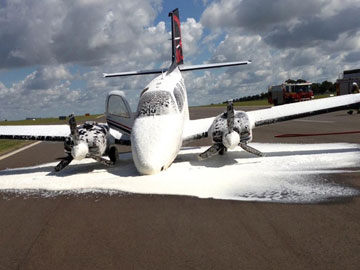
The ATSB is praising the crew of a Beechcraft B58 (Baron) for their handling of a nose landing gear collapse, which resulted in a wheels-up landing, without injury.
The aircraft, with a pilot and co-pilot on board, took off from Hervey Bay bound for Toowoomba, Queensland on 3 April 2013. Shortly after take-off, as the landing gear was being retracted, the crew heard a loud bang. They detected a possible issue with the aircraft’s nose landing gear and began troubleshooting.
After unsuccessful attempts to diagnose the exact problem or to manually extend the nose landing gear, the crew decided to leave it extended and continued to fly to Toowoomba. After flying over the runway at Toowoomba, ground personnel advised the crew that the aircraft’s nose landing gear had extended but was not in the locked position.
The crew took time to formulate a strategy for their landing, assigning responsibilities to each crew member and then rehearsed their plan.
The crew flew the aircraft to a training area to circle while emergency services were put in place for a wheels-up landing. During the next 45 minutes, they planned and rehearsed their landing in accordance with the aircraft’s flight manual. When advised that emergency services were in place, the crew elected to conduct a larger than normal circuit pattern to gain extra preparation time and so they would not feel rushed. The crew landed the aircraft in accordance with their plan. As the main landing gear touched down the pilot selected fuel and mixture controls off, while the co-pilot reduced the throttle settings to idle and switched off the electrical system. When lowered, the aircraft’s nose slid along the runway. The aircraft stopped and the crew safely exited. As a precaution, the aircraft was covered with fire retardant foam but there was no fire.
The aircraft had been built in the United States in 2012, was first registered in Australia on 29 January 2013 and had flown a total of 87 hours. An examination of the aircraft showed that the rod end of the nose landing gear forward retract rod had separated from the plunger tube on the nose landing gear plunger assembly. The examination suggested that there may have been a manufacturing issue. The nose landing gear of a second Baron aircraft built in 2012 with 127 hours service showed signs of a similar defect.
The manufacturer determined that a required copper braze had not been placed in the plunger tube and this had led to the rod end separating from the plunger tube. It was found that the assembly of the rod-end retract assemblies had been outsourced to an external supplier in 2012. The external supplier had outsourced the brazing process. Eight other assemblies were found to be faulty, and the manufacturer issued a mandatory service bulletin.
This incident highlights the benefits of flight crew using time to their advantage. The crew took time to formulate a strategy for their landing, assigning responsibilities to each crew member and then rehearsed their plan. This ensured they were well prepared, which ended in a safe outcome.
Read the report: Landing gear collapse involving a Hawker Beechcraft G58, VH-OMS, at Toowoomba Airport, Queensland, on 3 April 2013


